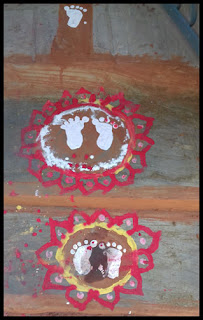 |
| Heart Of Myth Kindle Edition Amazon |
THE MYTHS OF THE CROW (APSAALOOKE) PEOPLE
Hello Blogosphere!
I’m
Dave Alber, the guest blogger for September on Stephanie Pope’s mythopoetry.com
blog.
In previous blogs… I introduced the core grammar of myth, described the alchemical nature of myth, as well as the ecological vision of polytheistic myth. We took a look at some of the characteristics of the mythology of Native North America.
In The Heart of Myth: Wisdom Stories from Endangered People, we explore the myths of six geographic regions (North America, Arctic, Central and South America, Africa, Asia, and Oceana.) Beginning with North America, lets take a look at one specific community of people in North America and their myth of world creation.
[What follows is from The
Heart of Myth.]
Chapter 1—Crow (Apsaalooke): The Earth Diver
The
Crow people call themselves the Apsaalooke,
meaning “people of the large beaked bird,” after a mythological trickster in
their oral tradition.[1] Many
modern Apsaalooke tell their history in mythological terms. “We know where we
came from, we know where we’ve been, and we know whom we are,” states the Crow
Nation website:
We came through three transitions to become who we
are. We were (Awaakiiwilaxpaake)
People of the Earth, we were all one mankind, we became (Biiluke) on Our Side, we became (Awashe) Earthen Lodges, and we became Apsaalooke some 2000 years
ago.[2]
The
ancestors of the Crow had varied life ways including hunting, gathering, and
farming, stories of which survive today in cultural memory. In the 1400s, under
the leadership of the legendary ancestor, No-vitals, the Crow people migrated
to the Great Plains culture area.[3] The
Native Americans of the Great Plains lived primarily through large game
hunting, particularly the buffalo, which people trapped in box canyons or
stampeded off cliffs. Small family tribes lived in portable tepees covered with
buffalo skins, each tepee being a symbol of the people’s relationship with the
land. “The tepee is a spiritual habitat that symbolically embraces her
occupants as a mother.”[4] With the
decline of the buffalo in the nineteenth century, the Crow people worked with
the United States to integrate into the European American culture.[5] Loss of
traditional lands has been a major threat to the Crow community. Today most
Crow people live on their reservation in south central Montana.[6] Many see
their children’s education as key to their cultural survival. For example, the
Crow or Apsaalooke language is vigorously maintained and taught in Crow
schools. This Siouan language is one of the most widely spoken Native American
languages.[7] Another
vital concern is the preservation of sacred lands. Oil drilling in Montana’s Valley
of the Chiefs, for example, endangers a religious site containing the largest
Native American collection of rock art.[8]
Myth: The Earth Diver
In
the beginning, there was just That Old Man Who Did Everything wandering around.
And it seemed to him that there was only his awareness . . . his attention . .
. his presence. He noticed the water below him, stretching out for as far as he
could see. But soon there were voices and circular ripples on the surface of
the water. He listened.
[1]
Grim, John A. and Magdalene Mocassin Top. “The Crow/ Apsaalooke in Montana.” Endangered Peoples of North America. Ed.
Tom Greaves. Westport: Greenwood Press, 2002. p. 23.
[2]
From the Official Site of the Crow Tribe: Apsaalooke Nation.
http://www.crowtribe.com/history.htm. Retrieved 12-30-08.
[3]
Medicine Crow, Joseph. The Crow Indians’
Own Stories. Lincoln: U. of Nebraska P., 2000. p. 23.
[4]
Grim, p. 23-4, 29. George Bird Grinnell relates a Blackfoot myth of the buffalo
maiden in his Blackfoot Lodge Tales.
Joseph Campbell retells the myth in his Historical
Atlas of World Mythology, Vol. 1, Part 2, and again in “The Message of the
Myth” segment of The Power of Myth
series.
[5]
Grim. p. 24.
[6]
Ibid. p. 23.
[7]
4,280 speakers in 1990 U.S. census.
Ethnologue: Languages of the World. http://www.ethnologue.com/show_language.asp?code=cro.
Retrieved 12-30-08.
[8]
Endangered Peoples of the World.
Sierra Club: Montana Chapter website. http://montana.sierraclub.org/weatherman.html.
Retrieved 12-30-08.
In
the beginning, there was just That Old Man Who Did Everything wandering around.
And it seemed to him that there was only his awareness . . . his attention . .
. his presence. He noticed the water below him, stretching out for as far as he
could see. But soon there were voices and circular ripples on the surface of
the water. He listened.
“I suppose it’s just us.”
“I suppose it’s just us.”
“Yeah,
there is no one else here.”
That Old Man Who Did
Everything followed the voices and the ripples in the water to their center,
where he saw four ducks. Two were blue-eyed ducks and two were smaller red-eyed
ducks. The small red-eyed ducks had just finished talking. On seeing someone
other than themselves they appeared shocked and even a bit embarrassed for just
having said that there was no one else about.“Ha,” laughed That Old Man Who Did Everything. “Did you really believe that you were alone? I am here, too.”
The
big blue-eyed ducks said, “Our hearts told us that there were others and we
believed.”
“Yes,”
smiled That Old Man Who Did Everything. “Tell me what your hearts say to you.”
“Our hearts say that there is something below the water.”
“Yes,” said That Old Man
Who Did Everything. “You can dive and swim through the water. Why don’t you
dive down, down, down and see what is there?”
So, the first blue-eyed duck dove down, down, down into the water. The others waited on the surface. Their friend had been gone a long time. “Maybe he is drowning,” said the second big duck.
“No,”
said one of the two smaller ducks. “He’s a good swimmer. He’ll be fine.”
At last, with a gasp, the big duck broke the surface of the water. The other ducks waited for him to catch his breath.
“Well?” asked That Old Man Who Did Everything. “What did you find?”
“Just
water, liquid currents pushing me to and fro, water above, water below.”
“Hmmm,”
said That Old Man Who Did Everything. He pondered the duck’s words.
The second big duck flapped his wings on the water’s surface. “I’m sure I can make it. I’m going to find out what’s below all this water.” And so, he dove down, down, down into the deep water and was gone a long, long, long time. That Old Man Who Did Everything waited with the ducks and they waited together for a long, long time.
“I don’t know if he is still alive,” said the first big blue-eyed duck.
“What
does your heart tell you?” asked That Old Man Who Did Everything.
“He’s alive,” said the
first small duck. “Look!”
He pointed where the surface of the water broke with feathers, a winged body, frantic splashing, and panting. The others waited for their friend to catch his breath.
After a time, he spoke,
“I
don’t know what there is down there. It seems to be all water.”
The first of the smaller red-eyed duck said,
The first of the smaller red-eyed duck said,
“These ducks are too big to reach the bottom. I’ll dive down this time. I know
I’ll make it!”
That Old Man Who Did Everything contemplated those words.
That Old Man Who Did Everything contemplated those words.
“You
are small,” he said. “So be careful not to go beyond the capacities of your
body. Bring awareness with you as you dive, maintain that awareness in the
depths, lest you should black out and drown. Remember to be aware in the
depths. I should be very happy to see you safely return to the surface.”
The
small red-eyed duck took a deep breath and dove down, down, down into the
depths of the water. Down, down, down he dove. On the surface, his friends
waited. They looked around at each other and waited, waited, waited.
Finally,
the small duck broke the surface of the water. He panted, but was quick to
catch his breath.
“Aha,” cried That Old Man Who Did Everything. “Tell me what did you find?”
“Aha,” cried That Old Man Who Did Everything. “Tell me what did you find?”
The small red-eyed duck said, “I swam down, down, down into the depths. Down, down, and down. And then my head struck something. And so, I placed that thing in my bill and carried it up to the surface.
He handed That Old Man Who Did Everything a small plant.
That
Old Man Who Did Everything turned the plant over in his hands as he eyed it
intently.
“Well, what your heart directly knew you have found through experience to be true,” he said, then turned to the second small red-eyed bird. “Now, you dive down, little brother, your friends are too tired. Beneath the water you will find something hard . . . and maybe beneath that there will be something soft. Take that soft something and place it in your bill. Bring it up to the surface.”
“Well, what your heart directly knew you have found through experience to be true,” he said, then turned to the second small red-eyed bird. “Now, you dive down, little brother, your friends are too tired. Beneath the water you will find something hard . . . and maybe beneath that there will be something soft. Take that soft something and place it in your bill. Bring it up to the surface.”
The fourth duck dove down, down, down into the water. He dove deeper, deeper, and deeper. Eventually, he struck something hard. He pressed his feet into it and broke that surface below. Deeper and deeper he went. His feet were now in something sticky and soft. He filled his beak with this soft something. Blowing air out of the nose holes in his beak, he rose to the surface. Up, up, up he rose and splashed on the surface.
“Aha,”
That Old Man Who Did Everything said, “Our friend.”
The
fourth duck was exhausted. He took the soft earth out of his beak and placed it
in That Old Man Who Did Everything’s hands.
That Old Man Who Did
Everything felt the earth in his hands. He looked at it, tasted it, and smelled
it.
“This is earth,” he said. “Creation can now begin.”
So, That Old Man Who Did Everything, with the aid of the ducks, divided the earth into four quarters . . . and directed the course of water on the land . . . and placed trees and living plants about . . . and arranged the sky above it all . . . and above the above they placed the sun, moon, and stars. That Old Man Who Did Everything addressed the ducks, “You have wings to fly in the air, feet to walk on land, and sleek bodies capable of swimming in the water. You embody this story of creation and transmit its knowledge in your flying, diving, and even in your most easygoing gestures. In the beginning, I brought my awareness to you. When men bring their awareness to you they will remember your story and progressively (or maybe all at once) attain knowledge of creation.
ABOUT THE AUTHOR
Dave Alber is the author of To the Dawn, Myth & Medium, and Alien Sex in Silicon Valley. His book The Heart of Myth is a global anthology of living myth that unpacks the grammar of world mythology. His website is DaveAlber.com and his English learning products are at EasyAmericanAccent.com.
DAVE ALBER SEPTEMBER GUEST BLOGS
Blog1
What Is Myth For You?
Blog 2
What Is The Core Grammar of Mythology?
Blog 3
What Is The Alchemy Of Myth?
Blog 4
What Is The Ecological Vision Of Myth
Blog 5
The Myths Of Native North America
Blog 6
The Myths Of The Crow (Apsaalooke) People

















